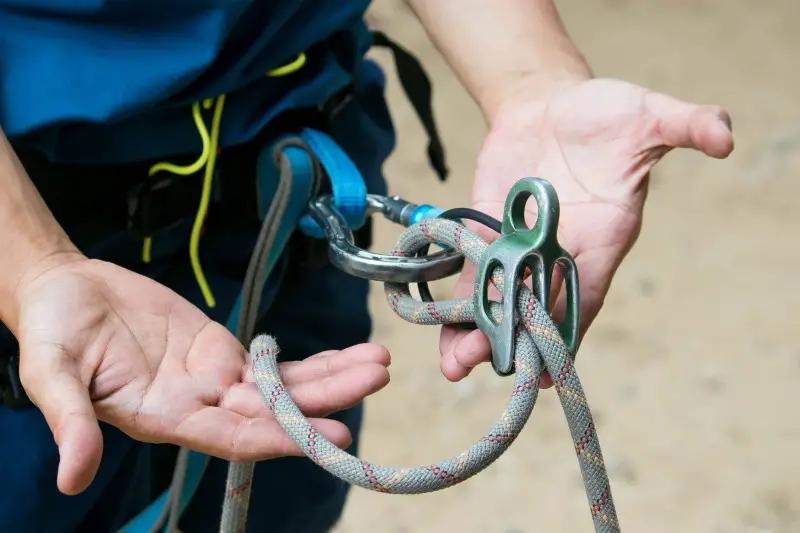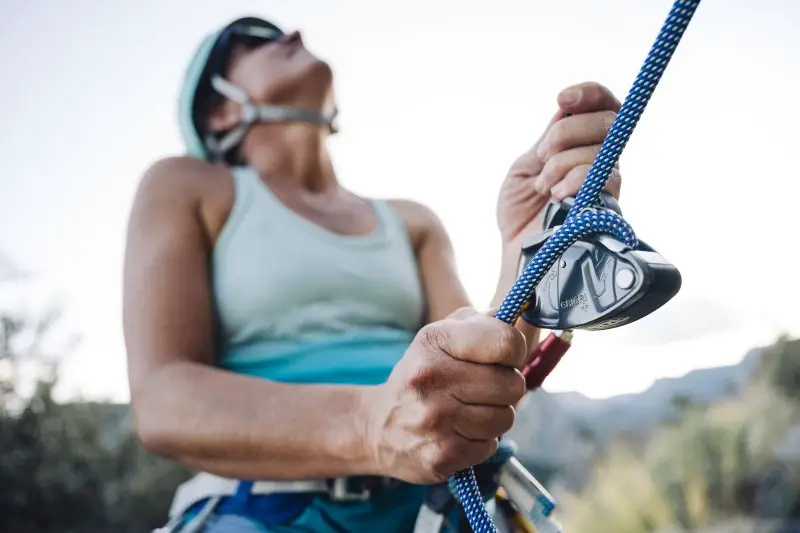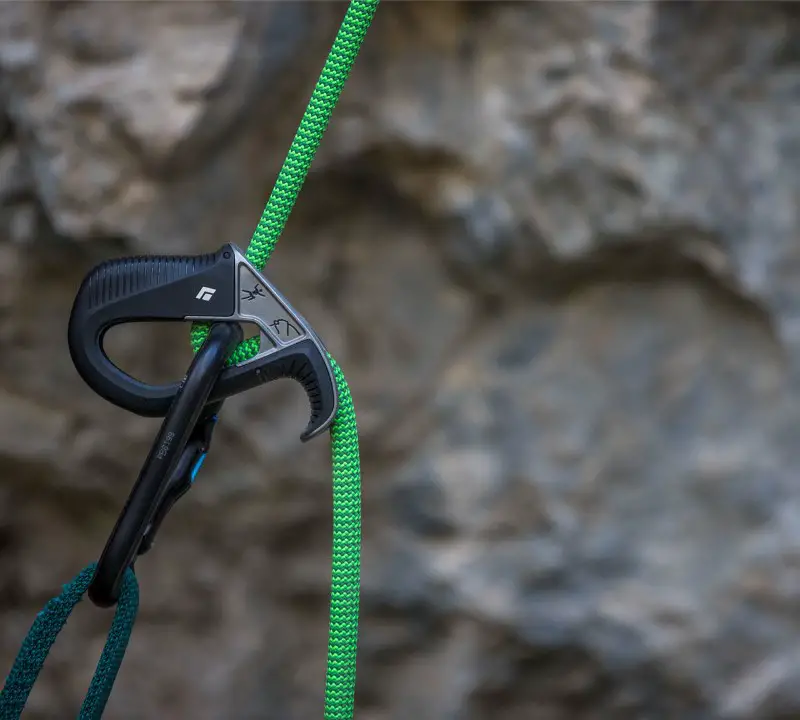As a rock climber, there is one tool that you are never going to leave behind when you head out for a day on rock, and that is your belay device. If you do happen to leave it behind, get ready to bail, ‘cause you ain’t going climbing that day (unless you’re partial to some free solo)!
The belay device is what manages the rope between yourself and your partner and is your lifeline. So, you can see how it is indispensable to the success of a climbing trip. But what is the best belay device to use? There’s a whole lot of different belay devices out there, but today, let’s take a look at two of the most popular belay devices out there: the Petzl Gri-Gri and the ATC – their respective advantages, disadvantages and best applications.
GriGri vs ATC Belay Device: What’s The Difference?
What is an ATC?
The ATC climbing device, which stands for Air Traffic Control, is a tube-style belay device, usually with two holes and a plastic-wrapped loop of braided wire connected to the underside. Many companies and manufacturers have created their own version of the tube-style device, but among the most popular are the Black Diamond ATC Guide, the Petzl Reverso and the ATC pilot.
All ATC models have a steel loop as part of the main body whose function is to provide an independent attachment point to a belay anchor – especially useful if you are belaying from above and even more useful when rappelling.

How to use an ATC belay device
The ATC is typically better suited to multi-pitch climbing and alpine environments. One distinct advantage it has over the Gri-Gri is that it can be used for a double-rope rappel. This means that any route you have to rappel off of pretty much requires an ATC or equivalent.
The ATC is not the best tool to use for a day out at the crag, especially if you and your friends are attempting something at or above your pay grade. With the ATC, the amount of slack you can pay out at one time is limited to how much rope you can simultaneously pull from the stack with your brake hand and subsequently pull up through the belay device. If the first pull isn’t enough, you have to go back with both hands and repeat the process. This can be cumbersome and inefficient when belaying someone on their project.
What is a GriGri?
If you have ever been curious about the origins of the name for the Petzl Gri-Gri, you’re not alone! Turns out, it is a term borrowed from an African Voodoo tradition: an amulet or charm that is meant to ward off evil from the wearer. A very fitting name indeed.

The Gri-Gri was first invented by Petzl in the early 1990s as an attempted remedy to the shortcomings of the ATC. The GriGri was designed with the car seatbelt in mind. When pulled slowly, slack comes out, when jerked, it locks.
The GriGri works in a similar way where the rope runs from the belayers through a channel and up to the climber. When the weight of a climber is applied and the rope is jerked upward, the cam activates and strangles the rope, stopping it from just whizzing through.
How to use a GriGri
We go into all the details of how to use a GriGri here, so take a look at that if you want to learn more about using it! But in essence, you feed the rope from the belayer side to the climber (there is a diagram on the GriGri that shows you).
To feed rope, you run your brake hand down, grab a big loop of rope and feed it out with your left hand.
GriGri vs ATC: The Pros & Cons
The GriGri and the ATC climbing device have the same aim: to keep the climber safe. However, their mechanisms and features vary from one another, while some climbers prefer the GriGri and others the ATC.
If you are not sure which one is best for you, here are some pros and cons of both belaying devices.
Petzl GriGri
Advantages:
- Assisted Braking: The GriGri has an assisted braking mechanism, which helps in catching falls more easily and reduces the physical strain on the belayer.
- Enhanced Safety: The assisted braking can be particularly useful in scenarios like gym climbing or sport climbing where falls are more frequent.
- Ease of Lowering: Provides smooth control when lowering a climber, especially beneficial for beginners.
- Good for Working Routes: Ideal for climbers working on difficult routes as it allows for easier takes and rests.
- Durability: Generally robust and long-lasting.
Disadvantages:
- Heavier and Bulkier: Compared to an ATC, the GriGri is heavier and takes up more space on the gear rack.
- Learning Curve: Requires proper technique to use safely; improper use can lead to accidents.
- Cost: More expensive than most ATC devices.
- Limited Rope Compatibility: Designed for a specific range of rope diameters.
- Can Promote Complacency: The assisted braking feature might lead to over-reliance and reduced vigilance in belaying.
It’s also worth mentioning that Petzl has a GriGri+ with an anti-panic lock. Great for beginners who are learning to use the GriGri or aren’t quite confident lead belaying yet but it has many other features that can make it hard to use, and even harder to achieve proficiency. The anti-panic lock can make it difficult to feed out rope as it can lock and makes it harder to rappel.
Side-note: Belaying is an artform which, just like rope management or anchor building, takes years to perfect. Even then, you should take care not to get complacent. The practicality of a device or the safeguards in place to correct for user error should NEVER be taken as permission to relax your diligence.
ATC Belay Device
Advantages:
- Versatility: Can be used with a wider range of rope diameters and for various climbing styles (e.g., multi-pitch, trad climbing).
- Lightweight and Compact: Easier to carry and takes up less space on the gear rack.
- Simplicity and Reliability: Fewer moving parts, making it less prone to malfunction.
- Cost-Effective: Generally more affordable than a GriGri.
- Promotes Active Belaying Skills: Requires and thus reinforces good belaying habits and techniques.
Disadvantages:
- No Assisted Braking: Requires constant attention and physical effort to catch falls, which can be more taxing, especially for beginners.
- Higher Skill Requirement for Effective Use: Demands a more experienced belayer, particularly in scenarios with higher fall potential.
- Less Smooth for Lowering: Can be more challenging to control the descent of a climber smoothly, especially for heavier climbers or beginners.
- Increased Physical Strain: Can be more tiring during long belaying sessions or with heavier climbers.
- Risk of Misuse: Incorrect threading or handling can lead to increased risk during belaying.
Both devices have their place in climbing, and the choice often depends on the specific needs of the climb, the preference and experience level of the climber and belayer, and the climbing environment. Personally, I use the GriGri to belay my climbing partner and the ATC for rappelling from multi-pitch climbing.
Black Diamond ATC Pilot vs GriGri
The ATC pilot, another Black Diamond belay device, is a tube-style device. Unlike the standard ATC, however, it only has one tube. As such, this device cannot be used for double-rope rappels and, on a multi-pitch climb that requires you to rappel, needs to be supplemented by an ATC guide.

How To Use the ATC Pilot
The beak-like shape of this device is a feature that allows for much quicker and easier paying out of slack, making it a more ideal tool for cragging. When you need to pay out slack for your climber to clip, you slide your hand up and hook your thumb under the beak. By pulling back slightly, you release the pinching action between the beak and the carabiner that the device is attached to. Keeping your hand on the brake strand of the rope but with a loose grip, you can pull armlength after armlength of rope through with your other hand.
Advantages
- Lightweight and Simple: It’s lighter and less complex than the GriGri, making it easy to handle and carry.
- Enhanced Safety: Offers increased safety with its assisted braking, especially useful for beginners or in scenarios where the climber is much heavier than the belayer.
- Smooth Rope Handling: Feeding and taking in slack is generally smoother compared to a GriGri, resembling traditional ATC devices.
- Lower Cost: Typically less expensive than the GriGri.
Disadvantages:
- Less Effective in Panic Situations: While it provides assisted braking, it may not be as effective as the GriGri in panic situations where the belayer might completely release the brake hand.
- Manual Lowering: Lowering a climber requires more manual control compared to the GriGri.
Which Belay Device Is Better?
Which one is better is a personal preference. Some climbers swear by the ATC and others are die-hard Grigriers.
Popularity
The Gri-Gri is one of the most innovative and effective belay devices on the market. It is arguably the most popular belay device out there and there is no doubt that most climbers nowadays would reach for a GriGri over an ATC.
Safety
The assisted brake on the Gri-Gri is meant as a safeguard to belayer error. While belaying your partner, especially on routes that require you to let out or take in great amounts of rope, it is not uncommon for mistakes to be made; mistakes such as accidentally (even if only momentarily) letting go of the brake strand. The Gri-Gri will act as something of a “second-hand,” even if the worst should happen and the brake strand is released. Regardless of the context – sport, trad, multi-pitch, single pitch, trad, alpine – it is inherently safer than the ATC.
The assisted brake mechanism on the Gri-Gri means that it can operate independently of the belayer (to a certain extent). If, god forbid, you are on an alpine route and are stricken unconscious by rockfall, the assisted brake on the Gri-Gri will keep your climber from falling to their death.
GriGris do malfunction! Do not rely on them to do the belaying for you. Always keep your hand on the brake side of the rope.
Easier on the Belayer
The assisted brake on the Gri-Gri also takes some of the pressure off of the belayer. If your climber is working a hard pitch and needs to hang for a while, the camming device is what will hold their weight. Always keep a hand on the brake strand, though! With an ATC, you as the belayer will need to exert active pressure on the brake strand to keep the rope from sliding through the device.
Which Belay Device Do You Prefer?
At the end of the day, I have seen a belayer use an ATC more proficiently than someone else who was fairly well-practiced with the GriGri. For the purpose of playing out slack, it should not matter which device you use; mastery is an achievable goal. That being said, the GriGri – minus being incapable of a double rope rappel – is the easy choice, every time. Occasionally, especially on harder multi-pitch routes, I will bring one of each – the GriGri for belaying and the ATC for rappelling. The key is to be versatile because there is no “one-size-fits-all” tool.



